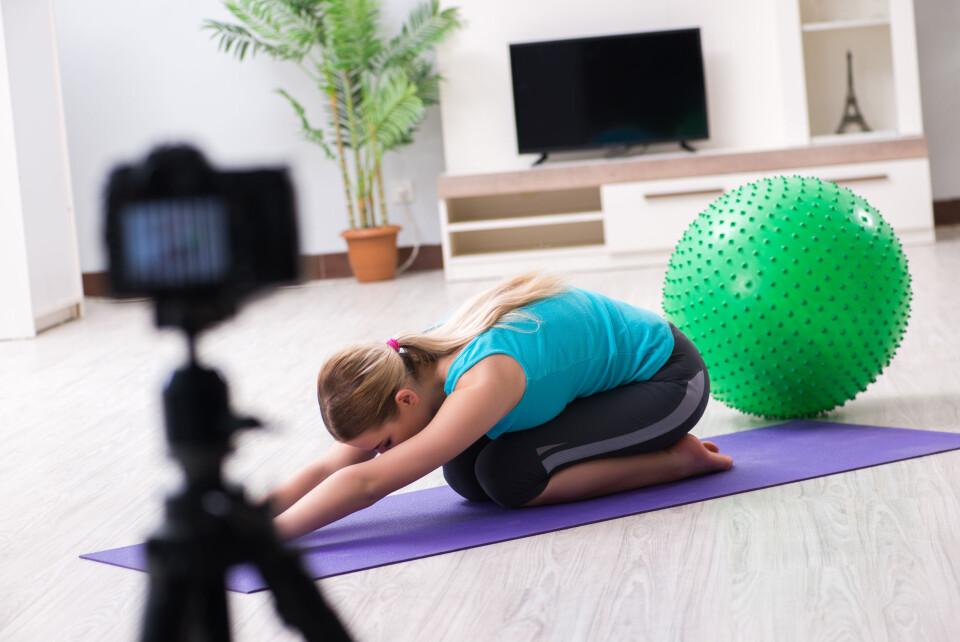Fagessay

Is COVID showing us the future for physiotherapy?
Fagessay i Fysioterapeuten.
David A. Nicholls, GradDipPhys, MA, PhD, SFHEA, Professor of Critical Physiotherapy, School of Clinical Sciences, AUT University, Auckland, New Zealand. David.nicholls@aut.ac.nz.
Karen Synne Groven, Professor, Oslo Metropolitan University; Professor VID Specialized University.
Yngve Røe, Associate Professor, Oslo Metropolitan University.
Tone Dahl-Michelsen, Associate Professor, Oslo Metropolitan University.
Wenche Bjorbækmo, Professor, Oslo Metropolitan University.
This essay was accepted May 27th, 2020. This is an edited and expanded version of a post published on David Nicholls` blog page:
https://criticalphysio.net/2020/05/06/is-covid-showing-us-the-future-for-physiotherapy/
Introduction
The recent promotional campaign from the Canadian Physiotherapy Association states that physiotherapists' work takes them 'from treating patients to moving people' (http://tinyurl.com/ya954p65). One reading of this is that physiotherapy covers a broad range of locations, from treating patients in clinics and hospital wards to working with people in their homes and communities. Another reading, however, suggests that physiotherapy is fundamentally changing: physiotherapists used to 'treat' people, now we prescribe exercise. Coming at the highpoint of the COVID-19 outbreak, the campaign reminds us how much the crisis has disrupted 'normal' physiotherapy, and how the pandemic might be reshaping our practice.
Physiotherapists have known crises before, however. And the configuration of modern-day physiotherapy owes much to our response to earlier calamities. World War I played a huge role in cementing physiotherapists as the orthodox providers of physical rehabilitation in many countries, and the polio epidemics that ran through the first half of the 20th century gave birth to many professional bodies (1). There are some essential differences between health care in the last century and healthcare today, though, and these differences might mean a very different outcome for the profession.
Physiotherapy in the last century benefited from two distinctive external influences: an established medical profession, and the welfare state 1. In centuries before, when there had been epidemics or massive social upheavals, there had been no social safety net to provide essential services for the population, and no established medical profession to partner with. People mainly had to fend for themselves. In the 20th century, developed countries had sufficient resources to build social welfare systems that, amongst other things, provided the infrastructure to support training and development of thousands of new health professionals, including physiotherapists.
Over the last 50 years, successive neoliberal governments have sought to reverse this trend, however, decentralising healthcare and reducing the size of the welfare state (2-4). Nation-states have opened up markets to greater competition, increased accountability for healthcare spending, placed more choice and responsibility in the hands of individual citizens, and challenged the historical power of the medical professions. So, notwithstanding the recent outpouring of support for healthcare workers, many governments throughout the world have been on a decades-long quest to reduce the influence of social welfare and the orthodox medical profession. This kind of service reform is only likely to accelerate in the coming years, as the costs of the pandemic dig deeply into national economic reserves.
Over recent weeks, healthcare workers all over the world have turned to online therapy as the only viable way to engage in practice, and some have wondered whether this represents a new market for physiotherapy services? But if people like Daniel and Richard Susskind are right, these innovations in practice might be leading professions like physiotherapy down a dangerous path.
In their book The Future of the Professions (5), the authors argue that successive decades of technical and work disruptions in industries like manufacturing, banking, and law, have taught us that anything you can practice as a discrete skill, or describe and explain in a language that others can easily follow, will almost certainly be lost to those who are cheaper to train and employ. But this is precisely what scores of physiotherapists are now trying to do on social media to promote their business. Because therapists can't be there in person, they are learning to show people how to do it for themselves and thereby showing those practices that may well be the first ones we lose from professional control.
And perhaps rightly so. Physiotherapists never owned essential fitness and strengthening programmes, tests for flexibility, treatments for minor injuries, or home-based rehabilitation programmes anyway. Our school curricula have been overloaded for too long with the kinds of skills that made sense when the profession sheltered under a legal, government, and medical protection. But it seems unlikely that physiotherapists will be able to claim expertise and the social capital that comes with it when the majority of our knowledge and skills become open-sourced.
We should already be thinking about the impact of this in our future curricula because the healthcare system will look dramatically different in 10 years when today's graduates are our senior practitioners. WWI and the polio epidemics forced physiotherapy to proliferate and consolidated the profession around a set of skills and abilities that still form the core of the profession's principles. But today we have the Internet, neoliberal economics, and climate changes, so it is inconceivable that the profession will not be radically altered when this catastrophic pandemic finally abates. Perhaps we already see the shape of the profession to come?
So what will be left?
It is becoming increasingly clear that the things that will define the profession in the future will be the things that cannot be so easily given away, described, or disseminated. These will be the kinds of things that require lengthy training, contemplation, complex problem-solving, inter-personal relations, person-to-person contact, and an understanding of health ecosystems both locally and in the broadest possible global sense.
In Norway, the pandemic triggered physiotherapists to change their approaches as clinics and practices were closed down (by the health authorities). Digital platforms, especially video consultations, were seen as a possible way to stay in touch with patients in primary as well as secondary health care. And thanks to the initiative of some physiotherapists working in private clinics, health authorities decided to support video consultations with tariffs that funded physiotherapists for their digital communications with patients. Before resolving this payment issue, physiotherapists in private clinics had been working for free because they could not let down their patients needing treatment and follow-up. So almost overnight, Norwegian physiotherapists could do what many doctors working in primary care, had been doing for more than two years, and offer individual digital treatment consultations.
But how has this digital shift changed the ways physiotherapists approach their patients? In a series of YouTube interviews physiotherapists elaborate on their experiences of using video consultations. These were physiotherapists working in different areas of clinical practice, including psychomotor physiotherapy, manual physiotherapy, children's physiotherapy, and sports physiotherapy.[1] What is interesting with these interviews is how the physiotherapists' notions of hands-on and hands-off therapy are changing. Hands-on contact, which is essential for many physiotherapists during tests and treatment, is no longer possible. Accordingly, verbal and non-verbal digital communication has become crucial substitutes.
Video consultations are now opening up new approaches and insights for psychomotor physiotherapists like Jorunn, a private practitioner with many patients struggling with anxiety and mental distress. Invited into her patients' homes, she is introduced through the video screen to the patient's dogs or invited into their living rooms and bedrooms when patients are sick in bed. She offers her patients emotional and social support, helping them to structure their daily life in isolation. In her approach, dialogue and communication have always been essential, but often in combination with hands-on therapy. Through the video platform, she instructs her patients how to palpate themselves, and tries to get them to help them to sense what they are feeling. From being the one testing and doing the touching, the patients are now the ones who must do this, and the therapists are finding new ways to communicate their practice.
Henriette, a paediatric physiotherapist, working in specialised health care, is now offering video consultations from her home, reaching out to children and their parents. Previously, she was the one testing and examining the children, but the parents need to do this now. Henriette has experienced this as a considerable change in her approach. She acknowledges that the children being tested and treated by their parents at home feel more at ease and more willing to cooperate than when they are in the hospital clinic. Of course, Henriette argues, communication through video consultations can never replace hands-on approaches, video communication can serve as a valuable tool and supplement when following up on parents and children in situations where they cannot easily come to the hospital. In this way, instead of doing all the assessment and treatment in one consultation, she can use video-consultations for follow up and after-care.
So, video consultations do offer some advantages, but they also fundamentally change the therapist's approach. When unable to use her own hands or her own body to understand how the child is responding to different handling, Henriette has to focus on verbal and non-verbal communication to guide the parents to perform necessary assessments and handling on their child. This change in practice can be challenging, even though it does enable new ways of interaction and participatory sense-making between therapist, child and parent. Henriette has said that she sees particular value in giving parents a central and decisive role in the assessment, handling and follow-up. They become significant partners in the process of understanding how the child reacts to different approaches, and they become even more crucial in finding strategies that seem to work best for the individual child and family.
Gustav is a manual therapist working in a private clinic, mostly treating patients with persistent pain. He emphasises a holistic approach in which conversation is crucially important. Through dialogue, he gains insight into the patient's burden. Gustav suggests that because communication was already crucial to his approach, it was relatively easy for him to transfer the physiotherapy sessions online. He sees the conversation as part of the physiotherapy treatment and that, for him, hands-on contact in the physiotherapy examination was only used to confirm or disprove the information that the patient had already provided. Asking the right questions is what matters in physiotherapy.
Gustav notes that video consultations don't always work well where the body of the therapist (and maybe several therapists) are needed; in in-hospital rehabilitation, for instance. In cases of early rehabilitation, where there is reduced mobility in the joints, he believes it is better to use physical touch if you can. But video consultation is going to be part of our future, and "Our profession is changing, and we see it all the time, and I am sure that video consultations belong in the future". Gustav argues for "Giving power and ownership back to the people", and combining the best of our work with the best of theirs.
Finally, Lasse works in a private sports clinic, and many of his patients arrive in the clinic after having orthopaedic surgery. Lasse's main work areas are orthopaedics and sports medicine. Lasse dreaded starting video consultations because he was worried patients would not like this kind of approach. The video consultations have worked very well, however. He knew some of his patients already, so had already undertaken physical examinations. This was not the case with the new patients, however. But these cases also turned out well. Lasse underscored the importance of the medical history, and sometimes patients need to be instructed how to perform specific tests themselves, like the standing meniscus test with rotations. Usually, Lasse would take the patients to the treatment bed after gathering some information on their history. He has needed to develop new approaches now. Lasse sends the patient photos and films to guide them on how to do tests and exercises. He misses the clinic with the equipment, and some clinical work requires a lot of creativity to make it work (resistance training, for instance).
In these examples, the physiotherapists talk about how context and context-sensitivity acquire new meanings. Treating patients through video rather than being face-to-face in the same setting at a clinic or hospital has changed what the therapist does because the medium through which they do it has fundamentally changed. The physiotherapists' unique competence is still there, but at the same time changing. The need to develop other skills and competencies seem necessary as digital platforms are gaining ground and popularity.
The potential for technological disruption to radically change practice is powerfully illustrated here. The specific human side of this relationship is of particular interest, as the users can "simply refuse to use the technology or use it selectively and even in novel and unexpected ways" (6). Verbeek argues that artefacts and technologies invite us to relate to them and, by so doing, make new, engaging physiotherapy practices possible. These are practices in which the objects partly 'withdraw' from peoples' attention, while still involving the users in their functioning, and by this mediate people's relationship both with their environment and actual situation as well as with the artefacts themselves (6).
Discussion
Before the era of modern medicine, doctors frequently consulted people in their own homes. The centralisation of healthcare around the doctor and the construction of large hospitals largely put an end to this practice (7,8). The COVID crisis has forced clinicians to relinquish many of the trappings of elite professional status. Many video consults have been run from people's homes where the practitioner cannot make use of the carefully designed clinical rooms and the expensive equipment as props to demonstrate their professionalism. Consultations have become much more democratic, and some of the power asymmetries that we engineered into our practice over past generations have been relinquished. And so being forced into video consultations may prove to be one more step in the process of power shifting that is seeing the responsibility for healthcare transferring inexorably towards service users, in their communities, and their own homes.
Physiotherapists have had to learn quickly how to show patients how to perform assessments and treatments on themselves, and in doing so, they have become like celebrity chefs, who teach us how to make incredible meals for ourselves at home. This change to practice has raised some challenging issues for the physiotherapist themselves, who, for much of their practice lives have been the ones doing the therapy for people. Practitioners have had to learn to experience their work vicariously and virtually, and some of the haptic hunger experienced by everyone over the last few weeks has been felt especially acutely by therapists, who have simply missed the hands-on connection with others.
For a long time, educating the patient has been an integrated part of physiotherapy practice. But this was a kind of education that often only meant transferring knowledge to the person. But in the present situation, where physiotherapists have not been able to control the therapeutic moment as carefully as they had been used to, the traditional role of the physiotherapist as an expert has shifted. Treatments based on video consultation imply increased autonomy for patients and may enhance people's self-efficacy and facilitate behaviour change (9,10), but this also means that the traditional role of the therapist as 'conductor' may have fundamentally changed.
The last few weeks have shown us that radical change in the nature and practice of physiotherapy is possible. If physiotherapists can work without any direct face-to-face contact and still provide valued services, what else might be possible? Why, for instance, should we limit our communication to only those clients within your local area? The Internet can take your work wherever there is an audience. And this might help address one of the major problems with modern expert practice, being that the services of the best are only available to a few 5. If geography ceases to be a barrier and we become a truly global profession, we will need entirely new ways to ensure that the profession retains its focus on the whole population, not just those who can afford us.
Traditional physiotherapy had no mechanism to scale services to hundreds, thousands, possibly millions of people. Now it can. It will be a very different kind of physiotherapy to the one that prospered in the 20th century, though. If physiotherapists are going to be allowed to expand and grow, they will need the support and cooperation of many people: registration authorities, educational institutes, professional bodies, government ministers, professional peers, and, of course, patients themselves. So only time will tell whether the COVID-19 crisis does for the profession what WWI and the polio epidemics did before.
References
1. Nicholls, D. A. The end of physiotherapy. (Routledge, 2017).
2. Harvey, D. A brief history of neoliberalism. (Oxford University Press, 2007).
3. Dutta, M. J. Neoliberal health organising: Communication, meaning, and politics. 1 edn, (Routledge, 2015).
4. Mladenov, T. Neoliberalism, postsocialism, disability. Disability & Society 30, 445-459, doi:10.1080/09687599.2015.1021758 (2015).
5. Susskind, R. & Susskind, D. The future of the professions. (Oxford University Press, 2015).
6. Verbeek, P. P. Artifacts and attachment: A post-script philosophy of mediation,. 125-146 (University of Amsterdam Press, 2005).
7. Armstrong, D. The rise of surveillance medicine. Sociology of Health & Illness 17, 393-404, doi:10.1111/1467-9566.ep10933329 (1995).
8. Thornquist, E. in Profesjonshistorier [The History of Professions]. (Pax forlag., 2014).
9. Bandura, A. Self-efficacy: toward a unifying theory of behavioral change. Psychol Rev 84, 191-215 (1977).
10. Biggs, J. & Tang, C. Teaching for quality learning at university. (Buckingham, ENG: The Society for Research into Higher Education and Open University Press, 2003).
Footnote
[1] See, for example, https://www.youtube.com/watch?v=EUIQUERjvjM&t=61s; watch?v=YPRdBuMophc; watch?v=7s1v7ZTrrIk; watch?v=I0Lk03HvdYk























